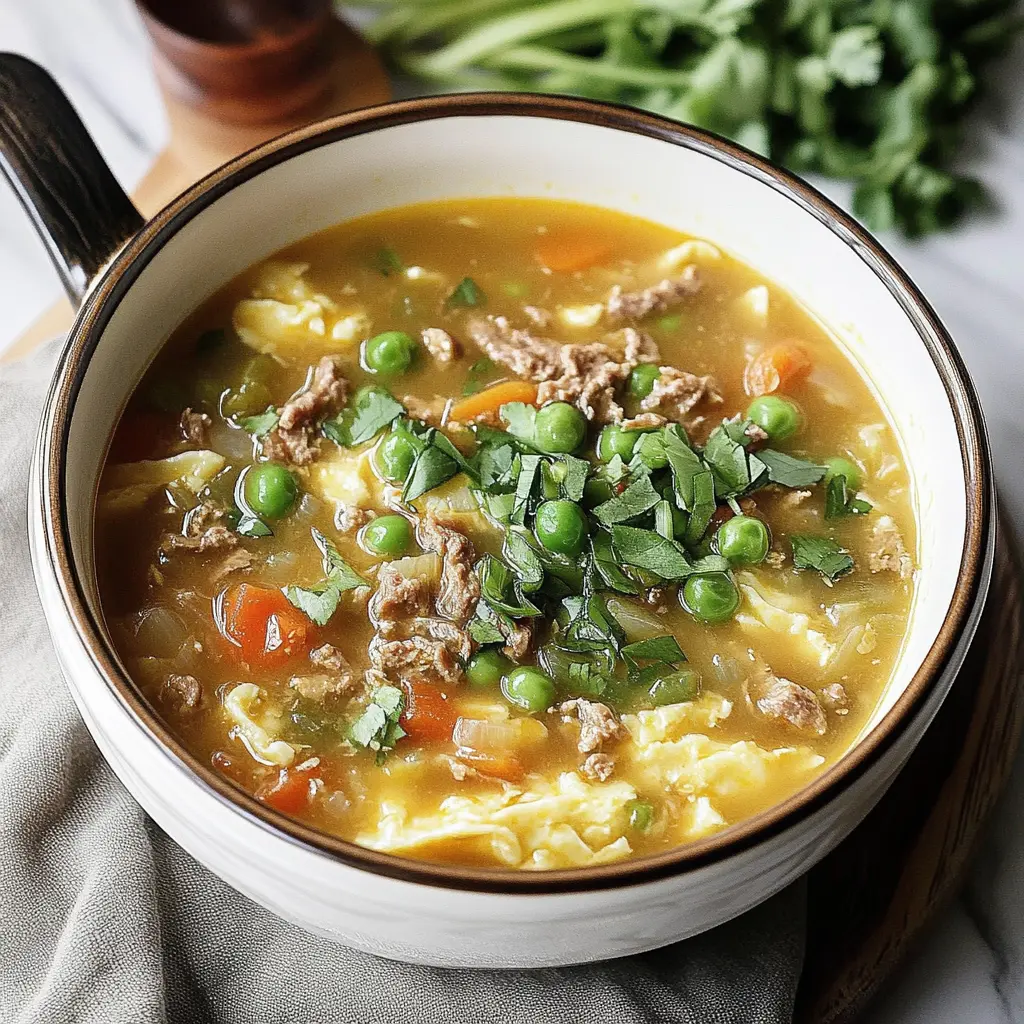Description of this recipe: Paleo Egg Roll Soup is a delightful and healthy twist on the classic egg roll appetizer, transformed into a hearty and satisfying soup. This soup captures all the familiar flavors of an egg roll – savory ground pork, crunchy cabbage, fragrant ginger, and a hint of umami – in a warm and comforting broth. It’s a perfect meal for those following a paleo or AIP (Autoimmune Protocol) diet, or anyone looking for a delicious and nutritious soup option. Free from gluten, grains, and refined sugars, this soup doesn’t compromise on taste. It is packed with wholesome ingredients that will leave you feeling nourished and energized.
Why you will love this recipe:
- It’s incredibly flavorful: This soup is a symphony of flavors, from the savory pork and aromatic ginger to the sweet carrots and tangy coconut aminos. Every spoonful is an explosion of taste.
- It’s quick and easy to make: Ready in under an hour, this soup is perfect for busy weeknights. The simple steps and readily available ingredients make it a breeze to prepare.
- It’s packed with nutrients: Loaded with vegetables and protein, this soup is a nutritional powerhouse. Cabbage, carrots, and onions provide essential vitamins and minerals, while ground pork delivers a healthy dose of protein.
- It’s versatile: This soup is easily customizable to your liking. You can add more vegetables, adjust the spice level, or swap the ground pork for ground chicken or turkey.
- It’s perfect for meal prepping: Make a big batch of this soup on the weekend and enjoy it throughout the week for easy and healthy lunches or dinners.
Ingredients:
- 1 lb ground pork (or ground chicken)
- Salt and pepper, to taste
- 2 tbsp coconut oil
- 1 small yellow onion, diced
- 3 cloves garlic, minced
- 1 small thumb ginger, peeled and grated
- 1 cup carrots, shredded
- 1 small green cabbage, sliced into strips
- 6 cups chicken broth
- 2 tbsp coconut aminos
- 1 tbsp rice vinegar (or lime juice for AIP)
- 2 tbsp green onion, chopped
- Optional: Sriracha to taste (omit for AIP)
Preparation:
Step 1: Brown the Ground Pork In a large pot or Dutch oven, place the ground pork over medium heat. Season with salt and pepper to taste. Break the pork apart with a spoon and cook until it is fully browned. This usually takes about 5-7 minutes. Ensure that the pork is cooked through with no pink remaining. Once cooked, remove the pork from the pot and set aside in a bowl. Be sure to drain any excess fat from the pot to keep the soup healthy and flavorful.
Step 2: Sauté Aromatics Return the pot to the stove and add the coconut oil. Allow the oil to heat up over medium heat. Add the diced yellow onion, minced garlic, and grated ginger to the pot. Sauté these aromatics for about 4 minutes, or until the onion becomes translucent and the garlic and ginger release their fragrant aroma. Stir frequently to prevent the garlic from burning, as burnt garlic can impart a bitter taste to the soup.
Step 3: Add Carrots and Cabbage Add the shredded carrots to the pot and cook for an additional 2-3 minutes. Cooking the carrots at this stage helps to soften them slightly and bring out their natural sweetness. Next, add the sliced green cabbage to the pot. Cook the cabbage until it begins to soften, which should take about 5-7 minutes. Stir occasionally to ensure the cabbage cooks evenly and doesn’t stick to the bottom of the pot.
Step 4: Combine and Simmer Pour in the chicken broth, ensuring it covers all the vegetables. Add the cooked ground pork back into the pot. Stir in the coconut aminos, which will add a savory umami flavor to the soup, similar to soy sauce but without the gluten and soy.
Bring the soup to a boil, then reduce the heat to low and let it simmer gently for 20-25 minutes. Simmering allows the flavors to meld together, creating a richer, more complex soup. The cabbage should become tender during this time.
Step 5: Finish and Serve In the last few minutes of cooking, stir in the rice vinegar (or lime juice for AIP). The vinegar or lime juice will add a touch of acidity, balancing the flavors of the soup. Taste the soup and adjust the seasonings as needed. Add more salt and pepper to taste, or a little extra coconut aminos for added depth of flavor.
Serve the soup hot, garnished with chopped green onion. If you enjoy a bit of heat, add a drizzle of Sriracha to your bowl. For those following the AIP diet, omit the Sriracha and enjoy the soup as is.
COOKING Rating: Easy
Serving Suggestions:
- Serve as a starter or a main course.
- Pair with a side salad for a light and healthy meal.
- Garnish with extra green onions, sesame seeds (if not following a paleo diet), or a drizzle of toasted sesame oil.
Tips:
- For a creamier soup, add a can of full-fat coconut milk during the last 5 minutes of cooking.
- If you don’t have coconut aminos, you can substitute with tamari or soy sauce (if not following a paleo or AIP diet).
- Adjust the amount of ginger and garlic to your liking.
- Add other vegetables, such as mushrooms, bok choy, or water chestnuts, for extra flavor and nutrients.
- For a spicier soup, add a pinch of red pepper flakes or a dash of hot sauce.
- To make this soup in a slow cooker, combine all ingredients in the slow cooker and cook on low for 6-8 hours or on high for 3-4 hours.
Prep Time: 15 minutes Cook Time: 35 minutes Total Time: 50 minutes
Nutritional Information: (per serving, approximate) Calories: 350 Protein: 30g Sodium: 500mg
Conclusion: Paleo Egg Roll Soup is a delightful and nutritious way to enjoy the flavors of egg rolls without the unhealthy ingredients. This soup is easy to make, packed with flavor, and customizable to your liking. Whether you’re following a paleo or AIP diet, or simply looking for a healthy and delicious soup option, this recipe is sure to become a family favorite. Enjoy the warmth and comfort of this flavorful soup any time of year.
5 Questions and Answers About This Recipe:
Question 1: Can I make this soup vegetarian or vegan? Answer: Yes, you can easily adapt this recipe to be vegetarian or vegan. Simply replace the ground pork with a plant-based alternative, such as crumbled tofu or tempeh. You can also add more vegetables, such as mushrooms or bell peppers, to make the soup more substantial. Be sure to use vegetable broth instead of chicken broth to keep it vegan.
Question 2: Can I freeze this soup for later? Answer: Absolutely! This soup freezes very well. Allow the soup to cool completely before transferring it to freezer-safe containers or bags. Be sure to leave some room at the top of the container, as the soup will expand when frozen. The soup can be stored in the freezer for up to 3 months. When ready to eat, thaw the soup in the refrigerator overnight and reheat on the stove or in the microwave.
Question 3: How can I make this soup spicier? Answer: If you like your soup with a kick, there are several ways to add more spice. You can add a pinch of red pepper flakes to the pot while the soup is simmering, or add a dash of your favorite hot sauce. For those following the AIP diet, consider using a compliant hot sauce or adding extra ginger for a bit of warmth. You can also serve the soup with a side of Sriracha or other hot sauce for those who want to add their own spice.
Question 4: What are coconut aminos, and can I substitute them? Answer: Coconut aminos are a savory seasoning sauce made from the sap of the coconut palm. They are similar in flavor to soy sauce or tamari but are gluten-free, soy-free, and paleo-friendly. If you don’t have coconut aminos on hand, you can substitute with tamari or soy sauce if you are not following a paleo or AIP diet. You can also use a small amount of fish sauce for a similar umami flavor.
Question 5: Can I add noodles to this soup? Answer: While this soup is traditionally served without noodles to keep it paleo and grain-free, you can certainly add noodles if you prefer. Choose a gluten-free noodle option, such as rice noodles or sweet potato noodles, to keep it paleo-friendly. Cook the noodles separately according to package directions and add them to the soup just before serving. Be aware that adding noodles will change the nutritional content of the soup.

